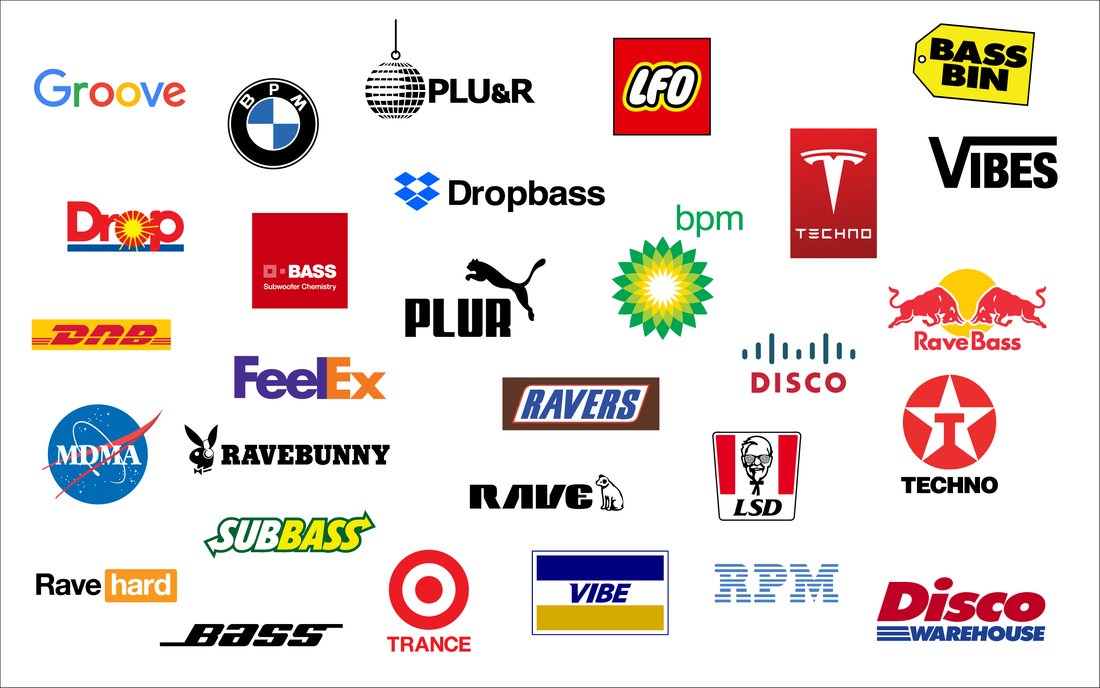Designs I Can't Publish

Thoughts on Parody, Sampling, and the Rave Scene
"Good artists copy, great artists steal."
— Pablo Picasso

In rave culture, the remix has always been a powerful tool, but it's not just about tracks spun by DJs; it's a whole mindset, from music to visuals to how we dress. When I sat down to create a line of parody tees riffing on big-name brands, it felt like tapping into that rebellious spirit of the underground. Sadly, copyright rules threw a wrench in my plans. Am I disappointed? Sure, a little. But I'm not at all surprised.
While I can't release those designs (at least, not officially), the experience got me thinking: parodying logos and sampling music are two sides of the same creative coin. They both take what's familiar and twist it into something fresh. If you've seen RIP: A Remix Manifesto, you know exactly what I'm talking about. That's one of my favorite documentaries because it dives deep into how remix culture pushes boundaries while battling copyright laws. This post explores how that all ties into rave culture — past, present, and future.
Throwing It Back: Rave Culture's DIY Roots

Back when raves were raw, underground, and secretive, creativity was all about rebellion. Flyers and merch often flipped big-brand logos into tongue-in-cheek statements. The Coca-Cola logo became "Enjoy Ecstasy," and Nike's swoosh got a rave-ready twist. These weren't just jokes — they were badges of identity. And when you're printing shirts and flyers yourself with your own equipment, there aren't any copyright bots to stop you.
Parodying mainstream brands wasn't just about taking shots at corporate culture; it was about remixing the familiar into something that spoke to the community. It was playful, clever, and oh-so-DIY. That creative energy made the rave scene feel like a world of its own — one you wanted to be part of.
Music Sampling as a Parallel

The concept of remixing isn't limited to visuals; it's at the heart of electronic music, too. Sampling — taking snippets of existing tracks to create new ones — has been a cornerstone of electronic music since the invention of the sampler. Think of those iconic beats in M/A/R/R/S's "Pump Up the Volume" or the energy The Prodigy brought with "Smack My Bitch Up."
Both practices — visual parody and music sampling — challenge the notion of "originality," demonstrating that creativity is about reimagining and recombining existing elements, not inventing from scratch. Sampling is more than just borrowing; it's storytelling. It's like saying, "Hey, remember this? Watch how I flip it into something you've never heard before." Just like parody logos, it's about using familiar pieces to build a new vibe.
The Copyright Racket
Here’s where it gets tricky: parody and sampling are creative gold, but copyright laws? They’re more about protecting big players than helping creators. Just ask Warner/Chappell, who held the Happy Birthday copyright (written in 1896!) until a 2016 lawsuit finally ended it. Parody is technically protected under fair use, but those lines blur fast. Sampling? Even riskier—artists have been sued over just seconds of a track.
The problem is that these laws were made for a world where creativity wasn't as collaborative or fast-moving as it is today. Like RIP: A Remix Manifesto says, "culture always builds on the past." If you lock it all up, you stifle the very creativity that makes culture exciting.
From Underground to Center Stage

Rave culture isn't what it used to be. Once gritty and underground, it's now packed into massive festivals with sponsorships and flashy production. That raw, rebellious energy? It's not just in history books of vintage rave designs — it's still out there. You just have to to dig a little deeper to find it now.
Even so, the remix spirit is alive. Whether it's streetwear brands flipping logos or DJs mixing old-school tracks with futuristic beats, the scene hasn't lost its creative edge. The tools and platforms might have changed (hello, Instagram and TikTok), but the heart of it — remixing culture to make it your own — is still beating.
Lessons from a Canceled Remix
Designing the 29 parody tees in the image at the top of this post was a journey. Sure, copyright rules blocked the final drop, but the process was a reminder of what makes remixing so powerful. It's about seeing something ordinary and turning it into something extraordinary.
The thing is, creativity thrives when it's challenged. Rave culture itself was born out of restrictions — legal, cultural, and otherwise. That's why it feels so revolutionary. Even if the world tries to tame it, remix culture finds a way to keep flipping the script.
Parting Thoughts

Rave culture has always been about turning the ordinary into something extraordinary. Whether it's parodying a logo or sampling a track, remixing is a way of saying, "Let's see where this can go." Even though some brands today continue to produce brand parody designs, I won't, partly out of respect for the agreements I have with my manufacturing and distribution partners, partly because if I do, I want to do it the old-school DIY way: silkscreened by hand and distributed in person, like the underground intended.
Yeah, copyright laws might make it harder, but the spirit of remixing isn't going anywhere. It's in every beat, every design, and every underground party that refuses to play by the rules. It keeps culture dynamic, allowing new voices to emerge and new stories to be told. As we figure out the complexities of copyright in the digital age, remember the value of remixing — not just as a tool for rebellion, but as a celebration of creativity itself.
– Jason @ Temple of Unicorns
Do you have thoughts on remixing in art and culture? I'd love to hear it in the comments below!